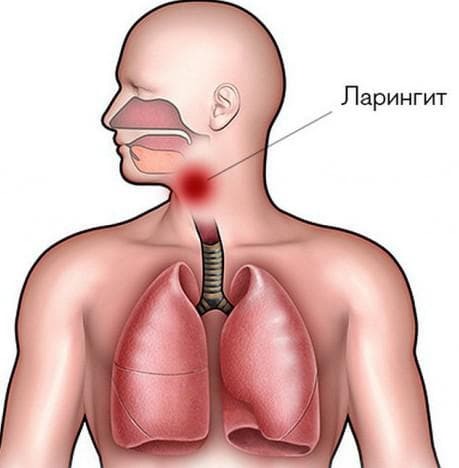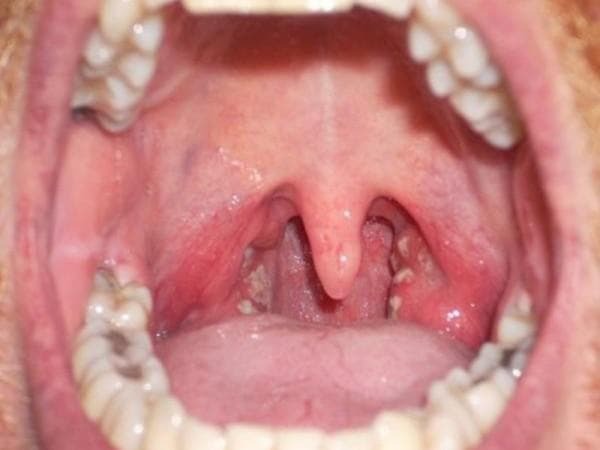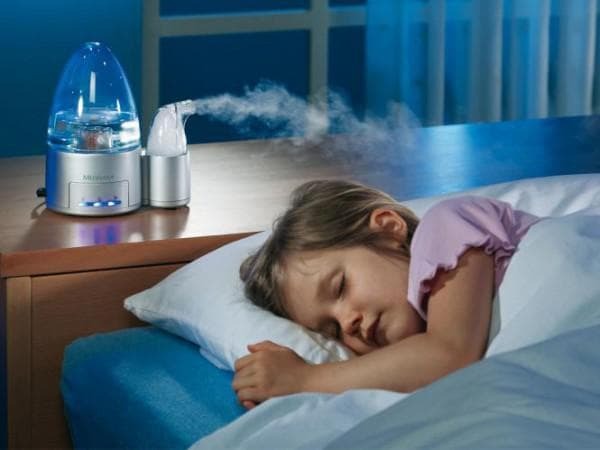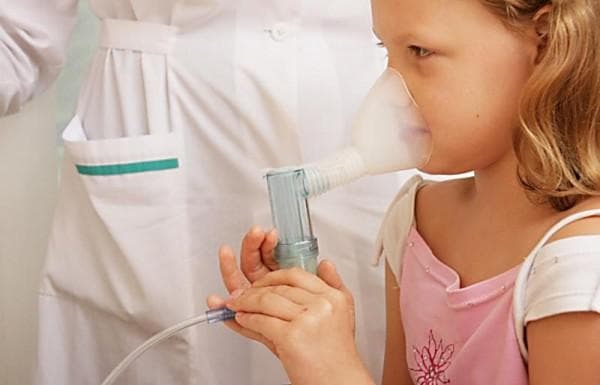
Laryngitis is a larynx disease in which the inflammatory process focuses on the vocal cords. In children, it occurs much more often than in adults, due to the reduced ability of the body to resist viral infections, as well as the increased risk that the child's respiratory system is always exposed to. Most often, the disease occurs as a side effect of an untreated acute respiratory viral infection and has a number of characteristics that make it impossible to let it go. Than to treat a laryngitis?
Contents
- 1
- 2 Disease
- 2 Tips
- 3 Tips The main causes of
- 4 The causes of illness relief in children of different ages
- 5 Prevention
- 6 First aid for doctor Komarovsky
Manifestation of

disease Laryngitis is characterized by the following manifestations:
- barking cough( here you can read about the treatment of dry barking cough inchild);
- a hoarse, altered voice, its partial or complete disappearance( here you can read how to treat loss of voice and hoarseness);
- itching and a feeling of dryness in the throat;
- fever.
What is the danger of laryngitis? The laryngitis can flow without temperature. In some cases( the smaller the child, the higher the probability), the patient may develop a laryngeal edema, the result of which is respiratory failure. It happens that such a disease occurs with stenosis. But better of course, that would be without it. The kid begins to choke and cry, and older children complain of shortness of breath. In no case should this terrible symptom be ignored - having noticed it, we must immediately go to the hospital, where the patient will be given emergency care.
On the video - symptoms and treatment of laryngitis in children:
Laryngitis is a complex disease in which the following forms are distinguished:
- catarrhal is the least dangerous, proceeds in mild form and is accompanied by symptoms typical for any ARVI: cough and slightly fever. Here, treatment and symptoms of catarrhal laryngitis are described;
- hypertrophic - is dangerous with laryngeal edema;
- hemorrhagic - characterized by the release during coughing sputum with blood veins. This is due to the fact that during the illness there is a hemorrhage in the mucous membranes of the larynx. This form of the disease is rare and only in the presence of predisposing factors: liver disease or cardiovascular system;
- diphtheria - differs in that the inflammation captures not only the larynx, but also tonsils;
- laryngotracheitis - with this form the disease also trachea;
- phlegmonous is the most severe form of the disease, complicated by the damage of the perichondrium, the muscular layer of the larynx, lymph nodes;accompanied by severe pain and fever;
- atrophic - characterized by thinning of the larynx, in children is extremely rare.

Most often, children have a catarrhal form of laryngitis, which is perfectly treatable at home and, with all the prescriptions of the doctor, does not leave complications afterwards. It is diagnosed by the pediatrician after the examination.
Tips
Do you need to take antibiotics for laryngitis in children when treating an acute form of a disease? And how long does laryngitis last for children and how many days does it take to treat it. It all depends on the form of the disease. This question can not be answered unambiguously - the decision to prescribe antibacterial therapy can only be taken by a doctor, taking into account the age of the child, his general condition, as well as all risks and possible complications. The most frequently used preparations are anti-inflammatory, antipyretic, antispasmodic, expectorant( syrups, tablets, lozenges), antiviral and antiallergic effects.
In the photo - laryngitis in children:

Any disease of the upper respiratory tract is characterized by the fact that there are not enough medicinal preparations for its treatment - it is necessary to adhere to the correct regime.
- The temperature of the patient's room should not exceed 22 degrees. In winter, when central heating is on, this can be difficult to achieve - in this case regular ventilation will help. Take the child out of the room and open the window - in a few minutes the air will cool. Ventilate the room at least three to four times a day. In the warm season you can not "clog" the room - a slightly open window does not damage the health of the child, but the stagnant, virus-laden air will aggravate his condition.

- Humidification of air , which, unfortunately, parents pay little attention. We must not forget that humidified air facilitates the patient's condition, promotes the liquefaction of mucus in the bronchi, moisturizes the nasal mucosa. To achieve the necessary humidity for the patient( 60-70%) can be with the help of special devices or spraying water in the room with a small spray. In the winter, wet towels and sheets, hung on radiators of central heating, will help.
- Drinking drink - fruit drinks, compotes of fresh, frozen and dry fruits and berries. Mineral water without gas( especially useful "Borjomi"), teas, herbal decoctions, juices. Observance of the drinking regime is very important, so suggest that the baby drink what he likes.

- Moisturizing the mucous membranes with a nebulizer or inhaler facilitates coughing, promotes sputum, and therefore accelerates recovery. Inhalations are carried out with the addition of saline or alkaline mineral water.

- Diet .From food, you must exclude all foods that can cause allergies or irritation of the mucous membranes of the larynx. The prohibited list includes citrus fruits, honey, chocolate, smoked products, spices, red fish.

- Clearing the nasal cavity of mucus .It is very important that in case of inflammation of the larynx the child breathes a nose, not a mouth, as breathing through the mouth dries the mucous membranes, causes coughing and aggravates swelling. Read how to remove stuffy nose with folk remedies.
Very carefully should be treated with folk remedies and essential oils - strong odors can not cure the disease, but exacerbate the patient's condition.
The video tells about vomiting with laryngitis in children:
The main causes of
The appearance of chronic laryngitis in a child is due to a weakened immune system and a number of external factors: frequent respiratory system diseases, acute respiratory viral infections, influenza, living in an unhygienic ecological zone, allergies, passive smoking,the lifestyle of the mother during pregnancy( non-compliance with diet, smoking, work in harmful industries).The occurrence of the disease is facilitated by the inhalation of varnishes, paints, animal hair and dust. There is also a congenital physiological predisposition to laryngitis - a narrowed larynx and / or a nasopharynx.
The video tells how to quickly cure laryngitis in a child:
Treatment of the disease, as in the case of the acute form, depends on its variety.
Catarrhal and hypertrophic forms of chronic laryngitis require the use of anti-inflammatory drugs, and astringents are used to relieve laryngeal edema. Sometimes, according to the doctor's prescription, it is necessary to irrigate the child's larynx with steroid aerosols in combination with antibacterial therapy.
Atrophic form of chronic laryngitis is treated with alkaline-calcium and saline-alkaline inhalations.
In all forms, mud applications, intra-oral electrophoresis, darsonvalization and UHF-inductothermy( electromagnetic field treatment) will be useful.
Features of getting rid of sickness in children of different ages
The most dangerous consequences are characterized by laryngitis in children from 6 months to a year. At this age, he can cause a so-called false cereal - a condition in which there is a strong swelling of the larynx and the baby can not breathe. The main thing is to reveal the signs. The danger is that the child can not describe his feelings. The symptoms described below should alert parents and become an occasion for an urgent call of an ambulance:
- breathing, which before was noisy, sharply becomes quieter .This means that the muscles involved in breathing are tired of overexertion. This symptom is dangerous because it produces a deceptive impression of improvement - it may seem to the parents that the child is getting better;
- blueing of the nasolabial triangle - the first sign of respiratory and heart failure;
- inhalation, which lasts longer than the exhalation of - the body tries to compensate for lack of oxygen;
- atypical and severe interderbria retraction and jugular fossa depression of the ( deepening on the front of the neck, at the junction of the clavicles and sternum) on inspiration.
The video tells what to do with laryngitis in a child:
When these symptoms appear, urgent hospitalization is necessary, as the child's health deteriorates very quickly. In the hospital, the baby's condition will quickly return to normal, and he will be able to breathe fully.
In one-year-old babies and 2-3-year-old children, false cereal appears much less often, but this does not mean that ominous symptoms can not appear at all. Parents must remember that the disease always progresses at night, and in the acute form of laryngitis periodically check the state of the child during sleep.
Patients aged 3, 4, 5 years and older carry the disease much better, so they are rarely prescribed antibiotic therapy - the disease is well treatable with anti-inflammatory drugs and physiotherapy.

Read what antibiotics you can drink with genyantritis.
How and how to treat a common cold in a child 2 years old.
The causes of otitis in infants: http: //prolor.ru/u/ detskoe-zdorove-u / simptomy-otita-u-malysha.html.
Prevention
To prevent the occurrence of laryngitis or reduce its risk, you can follow simple rules of hygiene and health: more to walk outdoors, to observe the temperature and humidity in the room. It is important to cure up to the end all inflammatory and viral diseases, especially those associated with respiratory organs. With frequent repetitions of the disease you need to get rid of everything that can accumulate dust and cause allergies: carpets, curtains, bedspreads with fluffy pile, various knickknacks and statuettes.
First aid for doctor Komarovsky
If you have symptoms of suffocation before the arrival of an ambulance, the famous pediatrician Eugene Komarovsky, like other doctors, advises to adhere to the following algorithm of actions.
- Provide access to damp and cool air: open the windows, take out the warmth of the dressed child on the balcony. Do not be afraid of high temperature: the number one task with croup is to restore full breathing.
- If the street is hot, you can alleviate the condition with the help of the air conditioner, and in its absence - bring the child to the bathroom and open the cool water. In a small room, the humidity will rise very quickly, and the air temperature, on the contrary, will decrease, and this will help the child to wait for medical assistance.
- It is obligatory to give an antipyretic drug( paracetamol or ibuprofen), a vasoconstrictive drug should be dripped into the nose.
- According to Dr. Komarovsky, the probability of cerebral cough is much higher in children with excess weight, so the preventive measures include proper nutrition and diet.
On the video - Dr. Komarovsky tells about laryngitis in children and his treatment:
It is strictly forbidden to give expectorant drugs to the child - increasing the amount of mucus coming out of the bronchi can lead to the fact that she will kill the larynx and the child will suffocate. Do not use inhalation with hot steam - if the larynx has dry crusts, then their swelling can also lead to a deplorable result. Another problem that can be faced by adults is pharyngitis. Read, than to treat throat with pharyngitis.
